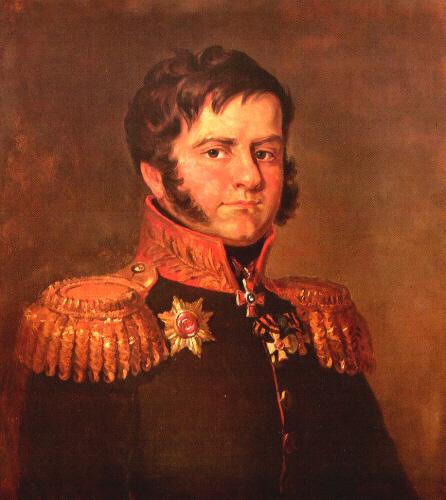|
|
|
|
|
|
|
|
|
|
|

(1771-1813) Lieutenant-General Dmitry Petrovich Neverovsky began his military service in the age of 15 as a private of the Life-Guard Semenovsky Regiment. A year after he was promoted to the rank of sergeant. In 1788 he took part in the Russian-Turkish war and in 1794 in the Polish campaign under the command of Alexander Suvorov. In 1804 Neverovsky was promoted to the rank of Major-General and in 1807 he was appointed the commander of the Pavlovsky Grenadier Regiment. In the beginning of the campaign of 1812 Neverovsky commanded the 27-th Infantry Division that had been formed by him before the war. In spring of 1812 Neverovsky with his division moved to the Western border of Russia and 10 days after the beginning of the war he joined to the Second Western Army of General Bagration. On July, 22, 1812 both Russian armies of Barclay de Tolly and Bagration joined together in Smolensk. The Russian were going to attack the long stretched French troops and rook the offensive to the West of Smolensk, but Napoleon had transferred his Corps to the left bank of the river Dnieper and moved swiftly from the South to Smolensk that stayed undefended in the Russian rear. The capture of Smolensk by the French troops would mean a catastrophe for the Russian army. There was only Neverovsky's division enforced by several cavalry regiments on the Napoleon's way to Smolensk near the town of Krasny. On August,2 Napoleon flung 15 thousand of Murat's cavalry and one infantry division on this detachment with the order to crush this covering detachment and capture Smolensk. In the very beginning of the battle the not numerous Russian cavalry was overran by the enemy. Neverovsky formed his battalions in square, the Russians allowed the thick mass of French cavalry to come near and opened the fire. They could repulse this attack. Then Neverovsky ordered to move towards Smolensk along the wide road lined with big trees. The enemy attacks followed one another, but Neverovsky's soldiers continued their moving fighting their way by fire and bayonets. At last after ten hours fighting Neverovsky's division approached a small river, the river crossing Neverovsky had prepared and occupied by one of his jager regiments with two guns before the battle. The French decided they met the big Russian forces and stopped the attacks. Neverovsky crossed the river and after giving a short rest to his troops he moved to Smolensk and on August,3 in the morning he joined the troops of General Raevsky that were approaching to Smolensk. After this battle Neverovsky with his division fought at Smolensk, Shevardino and Borodino. In the Borodino battle his division defended the "Bagration's arrows" (flashes) and suffered the very heavy losses, about two thirds of its number. And Neverovsky himself was contused but remained at duty. For the Borodino battle Neverovsky was promoted to the rank of Lieutenant-Lieutenant. Then Neverovsky's division took part in the Maloyaroslavets battle where it had heavy losses and after the battle was sent to Vilno for recruitmant. In spring of 1813 Neverovsky left Vino and joined the acting army. In the battle of Leipzig Neverovsky was mortally wounded and he died several days after. He was buried not far from Leipzig, but in 1912 his remains was taken to Russia and buried on the Borodino field near the monument to the 27-th Infantry Division. |
|
|
|
|
|
|
|
|
|
|
|
|